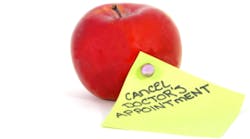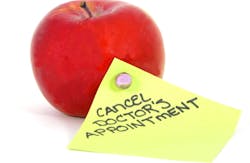Broken appointments a problem in your dental practice? Consider a hybrid scheduling system
Very few dental practices escape the headaches of cancelled appointments and no-show patients. Here's a different method of scheduling that might begin to help with the problem.
___________________________________________________________________________________________________
IF LAST-MINUTE CANCELLATIONS AND NO-SHOWS SEEM TO BE A PART OF THE DAILY ROUTINE IN YOUR DENTAL PRACTICE, it might be time to make some changes regarding how you schedule patients.
Broken appointments do nothing but wreak havoc on your day, add extra stress, and keep you from meeting production goals. While patients skip their appointments for many reasons, one of the most common is simply because they scheduled six months in advance, before they had any idea what their schedules would look like.
Other things often come up that patients consider more important than keeping their dental appointment, so they call your practice at the last minute to tell you they can’t come in after all, or they just don’t show up. This leads to headaches, and also costs your practice money.
I want to help you reduce the number of cancellations and no-shows you deal with each day. How, you may ask? I suggest implementing what I refer to as HYBRID SCHEDULING, which means you only pre-appoint those patients you’re confident will show up. This might include retired people who have more flexible schedules, and patients who have a track record of arriving to their appointments on time.
IT'S ALL ABOUT TIMING
Another idea? Schedule hygiene patients three and four months in advance. This enables you to get these patients in the books ahead of time, but not so far in advance that they forget about the appointment or that something else comes up.
You’re probably wondering when exactly you should schedule the rest of your patients. I suggest you send them reminders three or four weeks before they’re due to see you again. You can do this via snail mail, email, text, or phone call, depending on how they prefer to communicate with the office. If you use your patient communication system, you can set up reminders to be released at different intervals beginning 30 days before the appointment. Patients can then call, text, or email you to schedule their appointments.
This is especially helpful when you’re scheduling patients who are known to flake out. I’m guessing you can immediately think of a few offenders in your practice. If you contact these patients one month or so before they’re due for an appointment instead of insisting they commit to a time before they leave the practice following their last appointment, they’ll have a much better idea of what their schedule is. This means they’ll be less likely to cancel, which will reduce the number of broken appointments that add chaos to your day.
But it isn’t just the stress associated with broken appointments that causes damage to your practice. Broekn appointments also do a number to your bottom line.
While it’s nice to see the full schedule that results from appointing patients far in advance, keep in mind those appointments are occupying slots that could go to new patients or patients who want to proceed with treatment. Appointing far in advance often leads to long wait times to see the dentist—I’m talking weeks in some cases—which means many patients may call another practice rather than wait. If a good number of those pre-appointed patients end up cancelling, this results in a double whammy.
Need another reason to implement hybrid scheduling? I’ve also found that practices that rely on pre-appointing alone typically have not only high cancellation rates, they also have low patient retention numbers. As you know, none of this is good for your production numbers or your bottom line.
I understand that the idea of changing the way you schedule can seem a bit overwhelming. After all, you’ve done it your way for years. The problem is, if you pre-appoint all of your patients, it leads to broken appointments that cause you stress, hurt your production numbers, and cost you money.
Bottom line—if you reduce the number of cancellations and no-shows your practice must deal with, you’ll have a much healthier, more profitable practice. One of the best ways to do this is to stop relying on pre-appointing and implement a hybrid system. Trust me, you’ll be happy you did once you see production rise and cancellations fall. Not only that, you’ll have a much more streamlined and efficient practice and a lot less stress.
Are you still not sure hybrid scheduling is right for your practice? Feel free to reach out and I’ll help guide you through implementing this system. Together, we’ll make your practice more productive and profitable.








